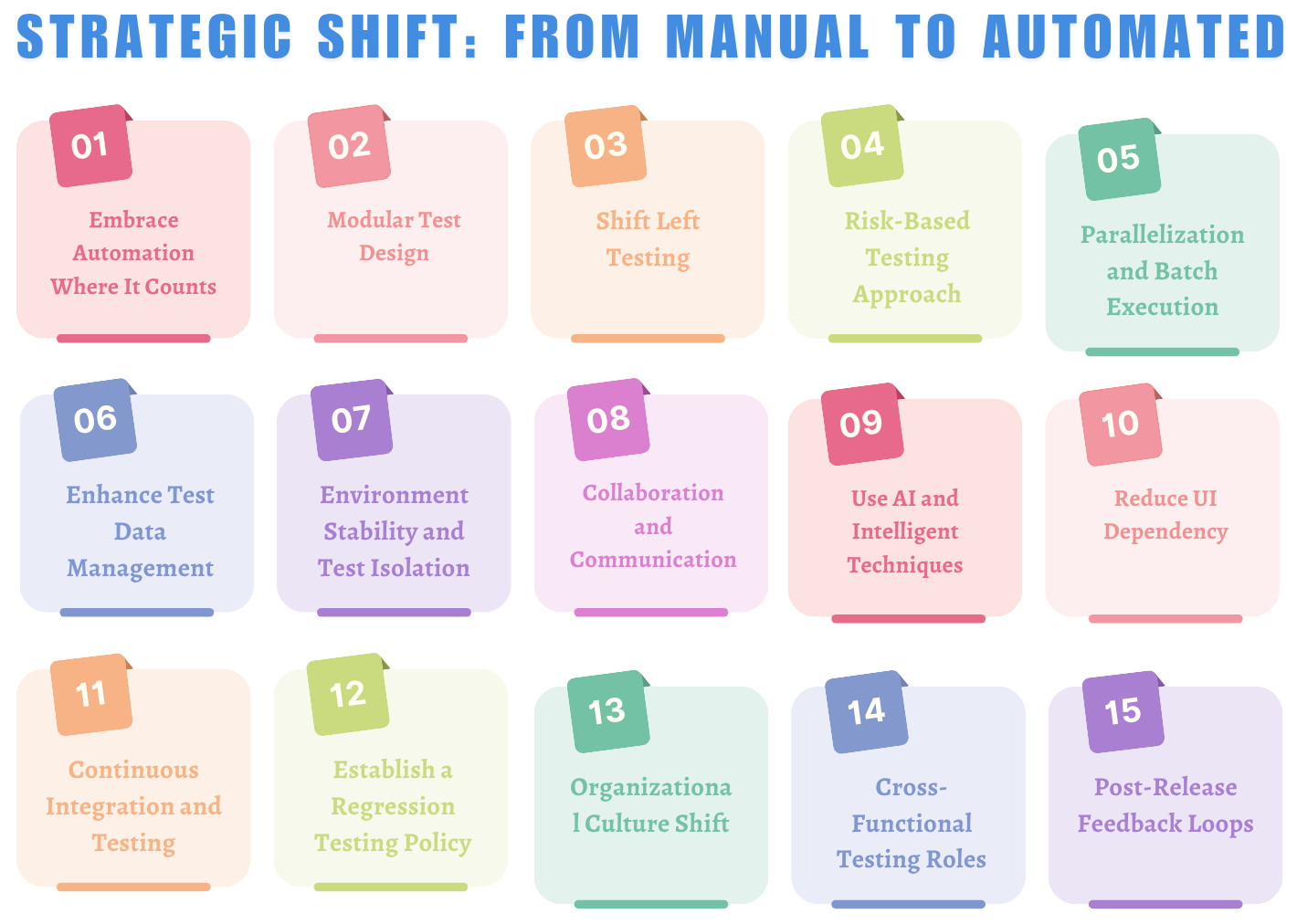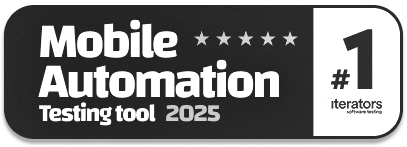How to Reduce Manual Regression Tests in Software Release?
|
|
Software development teams face immense pressure to deliver high-quality applications in a short period of time. In such a rapidly shifting space, regression testing becomes a bottleneck, particularly if it’s performed manually. Reducing the strain from manual regression testing is essential to increasing team velocity, to maintain software quality and to achieve continuous delivery.
In this article, we examine strategic, procedural, and technical methods to dramatically reduce manual regression testing during software release.

| Key Takeaways: |
|---|
|
What is Regression Testing?
Regression testing is when you test your software to make sure recent code changes such as a new feature, a bug fix, or performance changes, haven’t adversely affected a working feature. It acts as a protection from unintended behaviors and ensures previously-tested components are working as intended, even after updates.
Regression testing is important for system-level stability since a seemingly trivial code change can have far-reaching consequences in a complex application, especially in agile development processes.
Example: Imagine an e-commerce site in which a new feature is being released by the development team that permits its users to save items to a wishlist. Although the feature is not related to the checkout flow, it may reuse some backend components like product data, persistence or session handling.
If and when these shared elements are changed, they may inadvertently break the “add to cart” or “apply discount code” tasks. For this, you would retest the parts of the site not affected to make sure that the new wishlist feature hasn’t triggered bugs in other parts of the application, creating a full regression suite.
Why Manual Regression Testing Becomes a Burden
Manual regression testing is a labor-intensive, monotonous, error-prone, and budget-costly process. It needs a lot of human effort and human coordination, particularly if your test suite scales along with the complexity of the product. It is an inefficient method undesirable in today’s release cycle because human personnel are at risk of overlooking such a process, it takes a long period of execution, and is costly.
The Need for Reduction
Minimizing manual regression testing does not mean removing the relevance of regression testing. Instead, it means making it more efficient and sustainable as the software scales. It is about getting the most out of it, with smarter planning, better tooling, and improved integration into development workflows. The goals include:
- Faster release cycles by minimizing delays caused by repetitive manual test execution.
- Reduced costs through less reliance on large QA teams for routine checks.
- Increased accuracy by lowering the risk of human error during repeated test runs.
- Better resource allocation by allowing testers to focus on exploratory and high-value testing.
Strategic Shift: From Manual to Automated

Manual regression tests are no longer feasible as projects become more complex and deadlines grow shorter. Switching to automation allows teams to scale their testing efforts, lower the risk of human errors, and keep the rate of releasing high-quality code without impacting speed. This is a strategic choice that allows the system to release safely as fast and reliably as possible. Read about: Automated Regression Testing.
Embrace Automation Where It Counts
Automation is the quickest and most predictable way to minimize the overhead of manual testing, but we do not have to automate everything. Concentrate on the higher-impact areas where automation can bring the most value, as well as greater long-term cost-efficiency. Identify the following categories for automation:
- Smoke Tests: A suite of fast automated tests that check the most critical features in your product work after a new build. Understand more: What is Smoke Testing in Software QA?
- High-risk Functionalities: You can automate parts that change often or have significant user impact, as they are more likely to suffer from regressions.
- Stable Features: Unaltered and uniform characteristics are ideal to automate, as their behavior is usually known.
Prioritize Test Cases
Automation is not necessary for every test case. The priority of test cases can be determined through the impact, frequency of execution, and stability of the feature, which facilitates making the right investment in automation. Begin by finding expensive, time-consuming, and manually run high-value test cases that are prone to human error. Concentrate automation work in these areas so that you can automate quickly and gain valuable feedback and a good investment in your resources.
Establish Automation Criteria
It is necessary to determine whether a test case can be automated before automating it. Automating cases that don’t bring enough value is not worth it, so we should have clear criteria for that. Spend time and effort on the test that is going to bring the most benefit. Prudently chosen candidates yield greater testing efficiency and longer-term maintainability. A good candidate for automation should be:
- Repeatable: Testing should be frequent and should require the same test steps each time.
- Deterministic: It should be predictable for the same input to keep the service reliable.
- Stable (less UI/UX churn): The type of tests that should be aimed at features that are not changing much in terms of design or layout.
- High ROI: Automating the test should save significant time or effort compared to running it manually. Read: How to Get The Best ROI in Test Automation.
Modular Test Design
A modular test plan design enables teams to generate easily scalable and maintainable test suites by dividing so-called monolithic tests into manageable components. This abstraction provides greater clarity, increased re-usability, and also dramatically helps in removing the redundancy across test classes.
Reusable Components
Split large, monolithic tests into smaller, more reusable test modules that can be combined in various ways to test different flows without duplicating manual steps.
Layered Testing Approach
Take a layered approach in testing to ensure that you’re well covered and efficient:
- Unit Tests: Ensure that a single component or function works as expected separately.
- Integration Tests: Test that multiple components or systems work together.
- UI Tests: Validate entire workflows on your app to simulate how an actual user would interact with it.
By testing deeper layers earlier, surface-level regression tests can be reduced manually. Read: Test Automation Pyramid Done Right.
Shift Left Testing
It is the concept of pushing testing earlier in the software development life cycle, catching defects sooner, and helping avoid flaws throughout the system. By pushing testing to where it belongs, to the left, toward the beginning of development, teams can catch problems earlier, and there will be less re-work and less need for regression testing later. Read: Shift Left Testing – Software Testing Done Early.
Involve QA Early
Early involvement of QA in the development process also allows for the prevention of errors rather than finding them at a later stage. This early involvement enables QA to have insight into the product, guide a better product design and ensure that testing isn’t siloed to only a part of your software development until the end. QA can be involved during requirements gathering, design review and code walkthroughs.
Developer-Driven Testing
Promote developers to write unit and integration tests to get their code tested at the primary level. Advocate for Test-Driven Development (TDD) or Behavior-Driven Development (BDD) to increase a test-first approach and enhanced code quality. This helps save QA costs and reduces the burden on manual regression testing. Read: What is Test Driven Development? TDD vs. BDD vs. SDD.
Risk-Based Testing Approach
Risk-based testing enables teams to direct their efforts where they will have the most impact by measuring the likelihood and impact of individual potential failures. By doing so, the least amount of (available) testing resources are focused on the highest-risk areas to product stability, and the most on the user’s experience. Read: Risk-based Testing: A Strategic Approach to QA.
- Focus on High-Risk Areas: There are parts of the application that do not require the same level of testing, use risk-based approach to focus the testing on features that have been changed recently, components with known defects, and key testing functionalities that are used frequently or are core business functionality, causing high damage if they fail.
- Eliminate Redundancy: Stop retesting stable parts unless you know they have changed. Manually performing the risk-based testing reduces coverage.
Optimize Test Suites
As the applications grow, test suites become plagued by obsolete, duplicate, or fragile tests that make it difficult to keep them relevant as we iterate and make changes. You should also work to optimize that test suite to be slimmer and faster, with clearer output and more efficient use of resources. Routine housekeeping and intelligent choice of test gives you a lean and powerful test.
Remove Obsolete Tests
Outdated or redundant test cases not only waste time but also introduce noise and confusion in test results. Regularly reviewing the test suite helps retire tests for deprecated features, eliminate duplicates, and fix flaky tests to maintain reliability and efficiency.
Test Suite Minimization
Test impact analysis can help determine which test cases matter for a specific release. Tools or scripting may isolate the components affected by the change and only run tests related to them.
Parallelization and Batch Execution
It is critical to optimize the execution strategy for manual regression test execution to ensure that time is used effectively and efficiently. Teams can cut the time spent on tests by running them in parallel and grouping them logically to form batches, preserving coverage in the process. This technique improves the level of integration, prevents redundancy, and accelerates the release rate.
- Parallel Manual Testing: Categorize manual testers into focused sub-teams to complete simultaneous test cases. Create tight test charters to avoid overlap.
- Batch Regression: If full regression is unavoidable, group test cases by functionality and distribute them among testers as batches to increase throughput.
Enhance Test Data Management
Efficient test data management greatly contributes in reducing overloads of manual work and enhancing the reliability of regression testing. Bad data setup is a common cause of flaky tests, waiting time, and retesting. Standardized and automated data preparation means teams can deliver faster, repeatable and more reliable test cycles. Read: Optimizing Software Testing with Effective Test Data Management Tools.
- Use Synthetic Data: Create stable and repeatable test data to minimize setup time. This minimizes the reliance on hand-crafted (manual) data generation and the impact of differences in environments.
- Data Snapshots: Have a snapshot of databases or mock services which can be easily reset to known state before running the regression tests.
Environment Stability and Test Isolation
Unstable or shared environments are a common source of delays and false failures in manual regression testing. Ensuring a stable and isolated test environment helps achieve consistent, reproducible results and reduces the time spent troubleshooting environment-related issues.
- Dedicated QA Environments: One of the primary causes of slow manual testing is the volatile or shared testing environments. Give reliable regression running through dedicated test environments. Read: Managing Your Test Environment: What You Need to Know.
- Use of Containers: With containerized environments, such as Docker, tests can be run in easy-to-maintain equal environments which lessens flakiness and reduces the reasons to rerun tests manually. Read: What are Docker and Kubernetes and why do I need them?
Collaboration and Communication
There should be strong partnership between QA and development teams in order to perform regression testing in an effective manner. Open conversation means shared quality responsibility, less confusion and better focus on what needs to be tested in terms of both business value and technical capabilities.
- Close QA-Dev Collaboration: Frequent collaboration between QA and developers reduces ambiguities and ensures that the right tests are written. Daily standups, sprint grooming sessions, and retrospectives develop a shared understanding of quality.
- Documentation and Traceability: Well-documented features, user stories, and test plans reduce the time spent in manually investigating what to test. Using a traceability matrix helps ensure only affected components are tested.
Use AI and Intelligent Techniques
Implementing AI-powered methodologies in testing can lighten the load of manual regression by making testing intelligent and focused. These are applied to help teams in finding where areas are high risk, where testing effort should be prioritized and manual checks should be rethought.
- AI-based test automation: testRigor helps manual testers create automation scripts easily using plain English. With its NLP-based (Natural Language Processing), Gen AI engine, and AI context, testRigor translates human-readable instructions into robust automated test cases, allowing non-technical users to contribute effectively to test automation with minimal training.
- Visual Testing: testRigor helps to perform UI checks between versions to identify the smallest changes inside the screens compared to older releases. This type of testing is a challenge to perform manually. Since it’s both time-consuming to do, and difficult to automate across browsers and devices.However, with testRigor, you can now do it automatically, completing tests faster, and ensuring your sites look the same regardless of who might be using them. Read: How to do visual testing using testRigor?
Reduce UI Dependency
Heavy dependence on UI tests will lead to slow regression cycles and can also result in flaky tests with the frequently changing UI. Moving some of the testing load down into the application stack improves velocity, stability, and maintenance.
- Use API Testing: APIs are more stable and faster than UI tests. Validate backend logic via APIs, reducing the need for complex and brittle UI-based manual regression.
- Headless and Service Layer Tests: Design tests to interact with services directly rather than through the user interface. This approach is both faster and more robust.
Continuous Integration and Testing
Testing as part of the development pipeline is a must for modern high velocity teams for releasing quality software. Continually test and validate change as it occurs with Continuous Integration (CI) and Continuous Testing to prevent building up defects until things hit production.
- Integrate Tests into CI/CD Pipelines: Automate regression tests to run on every commit or on a nightly basis. This ensures regressions are caught early and often, reducing the need for lengthy manual cycles at release time.
- Early Feedback Loop: Short feedback loops reduce rework. With every merge, automatically triggered tests surface defects instantly, reducing the regression scope for manual tests.
Establish a Regression Testing Policy
In order to make the most effective use of test resources, it is crucial to define what kind of regression testing should be done, and when. A mature process can prevent unnecessary tests, without loss of confidence in the quality of the software.
- Define Triggers for Regression: Not every update warrants a full regression cycle. Use a regression trigger matrix based on factors like change size, feature risk, and release type (major, minor, or patch) to decide the appropriate level of testing and avoid unnecessary effort.
Organizational Culture Shift
- Promote Quality Ownership: Make quality everyone’s responsibility—not just QA’s. When developers own more testing and product managers help prioritize testing efforts, manual regression naturally decreases.
- Reward Prevention Over Detection: Celebrate teams that reduce regression bugs via better practices, not just those who detect them late. This mindset reduces downstream manual effort.
Cross-Functional Testing Roles
- Rotate Testing Responsibilities: Let developers, business analysts, and other roles participate in regression testing through defined rotations. This spreads testing knowledge and reduces reliance on a single QA team.
- Crowdsource Testing Internally: Before major releases, engage broader teams (support, product, marketing) to perform guided manual tests. This captures edge cases and reduces repetitive QA regression.
Post-Release Feedback Loops
- Monitor Production Logs: Analyze logs, crash reports, and user feedback after each release to detect undetected regressions. This data can help eliminate unnecessary tests for future cycles.
- A/B Testing and Canary Releases: Deploy to a small group before global rollout. Detects regressions from a subset of users, minimizing manual test overhead. Read: What is Canary Testing?
Wrapping Up
Trimming down the manual regression test suite is not about compromising quality, it is about making testing more efficient, scalable, and in line with modern development practices. By automating judiciously, with risk-based coverage and removal of duplicate tests, teams can optimize resources while maintaining confidence. By giving QA the tools it needs and developing a culture where everyone owns quality, we amplify this impact. Combined, these practices allow for faster releases of higher-quality software and increase user satisfaction.
| Achieve More Than 90% Test Automation | |
| Step by Step Walkthroughs and Help | |
| 14 Day Free Trial, Cancel Anytime |












